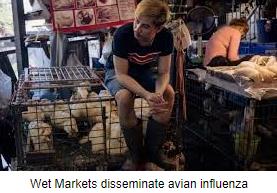
 The possibility that H10 strains of avian influenza have zoonotic potential is under review by public health authorities. Both human-derived and chicken isolates have a high affinity for sialic acid-alpha-2,6-galactose receptors. It is possible that some chicken-derived strains of H10 virus may infect human contacts without necessarily undergoing mutation. The hemagglutinin and neuraminidase genes of H10N3 are common to viruses with a Eurasian lineage.
The possibility that H10 strains of avian influenza have zoonotic potential is under review by public health authorities. Both human-derived and chicken isolates have a high affinity for sialic acid-alpha-2,6-galactose receptors. It is possible that some chicken-derived strains of H10 virus may infect human contacts without necessarily undergoing mutation. The hemagglutinin and neuraminidase genes of H10N3 are common to viruses with a Eurasian lineage.
H10N4 avian influenza virus was responsible for a clinical outbreak in mink in Sweden in 1985. H10N7 cases occurred among human contacts of chickens during 2004 in Egypt and in  2012 among workers in a processing plant in Australia.
2012 among workers in a processing plant in Australia.
The WHO and the WOAH through a network of international reference laboratories are characterizing influenza viruses isolated from both avian and mammalian species to monitor for changes in that may suggest zoonotic potential in advance of a pandemic.